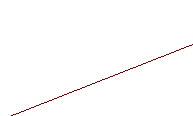
Here is some additional information on the process and how it will fit into your course:
One of the predominant features of your course is the question-answer format for submitting work.
As with the first couple of questions, the questions in this document can be answered with just a knowledge of basic high-school mathematics.
Sometimes the given solutions are more subtle than you might expect, and you will probably find that many of your answers, while good and correct, do not completely match the given solution. This is intentional, the goal being to get you used to the idea and the benefits of the self-critique process.
The process is fairly simple, and you'll be using it again and again.
Your basic instructions follow. Rather than giving you the instructions at the beginning of the document, you were given a couple of questions to serve as a point of reference, and should now be better prepared to understand the instructions:
1. Answer each question, then look at the given solution:
It is expected that you will answer each question before looking at the given solution. There is no grade penalty for looking ahead, but if you do you:
- may be bypassing an opportunity to engage yourself in the solution process
- run the risk of deluding yourself about what you understand
- are likely to learn much less and
- are not as likely to do well in the course.
However your instructor understands the tradeoffs involved in being a student, and makes no judgement about how you should use this material. As long as you use it to your best advantage and succeed on tests and other course activities, you will get a good result from this course.
2. If you can't readily work it out in your head, use pencil and paper, and keep a record of your work.
You aren't expected to work out your solutions by staring at a computer screen, though you will likely find many questions and problems easy enough to do 'in your head'. However on more challenging problems, it's easier to work things out using a handwritten document than a computer-created or word-processed document.
- You should in general work out your answers to non-obvious problems on paper, jotting down sketches, diagrams and notes as you go, in such a way that you can make sense of it later. This will help you focus your work and maintain your train of thought, and will be quite valuable for periodic review. It is recommended (and may in some courses be required) that you dedicate a notebook to this course, and at least sketch out your work in the notebook.
3. There's no need for special formatting or graphs:
4. Expect to see your work posted by the instructor in a timely manner:
After submitting your work, per instructions at the end of this document, you should expect to see your work posted, along with instructor commentary, at your access page. It should be posted by the evening of the day after you submit it, and may well be posted the evening of the same day.
Question: `q001. If you are earning money at the rate of 8 dollars / hour and work for 4 hours, how much money do you make during this time? Answer in such a way as to explain your reasoning as fully as possible. A solution to this problem appears several lines below, but enter your own solution before you look at the given solution.
Your solution: (type in your solution starting in the next line)
Confidence Rating:
Your Confidence Rating should be entered on the line above, after the colon at the end of the prompt.
Your Confidence Rating is a number from 0 to 3, which is to indicate your level of confidence in your solution.
3 means you are at least 90% confident of your solution, or that you are confident you got at least 90% of the solution
2 means that you are more that 50% confident of your solution, or that you are confident you got at least 50% of the solution
1 means that you think you probably got at least some of the solution correct but don't think you got the whole thing
0 means that you're pretty sure you didn't get anything right)
Given Solution: 8 dollars / hour means '8 dollars per hour', indicating that for every hour you work you earn 8 dollars. If you work for 4 hours, then if you earn 8 dollars for every one of those hours you earn 4 * 8 dollars = 32 dollars.
Self-critique (if necessary): If you are sure your solution matches the given solution, and/or are sure you completely understand the given solution, then just type in 'OK'.
Otherwise you should include a self-critique. In your self-critique you should explain in your own words how your solution differs from the given solution, and demonstrate what you did not originally understand but now understand about the problem and its solution.
Note that your instructor scans your document for questions and indications that you are having difficulty, usually beginning with your self-critique.
If no self-critique is present, your instructor assumes you understand the solution to your satisfaction and do not need additional information or assistance.
If you do not fully understand the given solution, and/or if you still have questions after reading and taking notes on the given solution, you should self-critique in the manner described in the preceding paragraph.
Insert your 'OK' or your self-critique, as appropriate, starting in the next line:
Self-critique Rating:
Your self-critique rating should be entered on the line above, after the colon at the end of the prompt.
Your self-critique rating is a number from 0 to 3, which is to indicate your level of confidence in your solution.
(If you believe your solution matches the given solution then just type in 'OK'.
Otherwise evaluate the quality of your self-critique by typing in a number between 0 and 3.
3 indicates that you believe you have addressed all discrepancies between the given solution and your solution, in such a way as to demonstrate your complete understanding of the situation.
2 indicates that you believe you addressed most of the discrepancies between the given solution and your solution but are unsure of some aspects of the situation; you would at this point consider including a question or a statement of what you're not sure you understand
1 indicates that you believe you understand the overall idea of the solution but have not been able to address the specifics of the discrepancies between your solution and the given solution; in this case you would normally include a question or a statement of what you're not sure you understand
0 indicates that you don't understand the given solution, and/or can't make a reasonable judgement about whether or not your solution is correct; in this case you would be expected to address the given solution phrase-by-phrase and state what you do and do not understand about each phrase)
Question: `q002. If you work 12 hours and earn $168, then at what rate, in dollars / hour, were you making money?
Your solution: (type in your solution starting in the next line)
Confidence Rating:
Your Confidence Rating should be entered on the line above, after the colon at the end of the prompt.
Your Confidence Rating is a number from 0 to 3, which is to indicate your level of confidence in your solution.
3 means you are at least 90% confident of your solution, or that you are confident you got at least 90% of the solution
2 means that you are more that 50% confident of your solution, or that you are confident you got at least 50% of the solution
1 means that you think you probably got at least some of the solution correct but don't think you got the whole thing
0 means that you're pretty sure you didn't get anything right)
Given Solution: $168 earned in 12 hours implies that $168 / 12 = $14 were made per hour, so the rate is $14 / hour.
Self-critique (if necessary): If you are sure your solution matches the given solution, and/or are sure you completely understand the given solution, then just type in 'OK'.
Otherwise you should include a self-critique. In your self-critique you should explain in your own words how your solution differs from the given solution, and demonstrate what you did not originally understand but now understand about the problem and its solution.
Note that your instructor scans your document for questions and indications that you are having difficulty, usually beginning with your self-critique.
If no self-critique is present, your instructor assumes you understand the solution to your satisfaction and do not need additional information or assistance.
If you do not fully understand the given solution, and/or if you still have questions after reading and taking notes on the given solution, you should self-critique in the manner described in the preceding paragraph.
Insert your 'OK' or your self-critique, as appropriate, starting in the next line:
Self-critique Rating:
Your self-critique rating should be entered on the line above, after the colon at the end of the prompt.
Your self-critique rating is a number from 0 to 3, which is to indicate your level of confidence in your solution.
(If you believe your solution matches the given solution then just type in 'OK'.
Otherwise evaluate the quality of your self-critique by typing in a number between 0 and 3.
3 indicates that you believe you have addressed all discrepancies between the given solution and your solution, in such a way as to demonstrate your complete understanding of the situation.
2 indicates that you believe you addressed most of the discrepancies between the given solution and your solution but are unsure of some aspects of the situation; you would at this point consider including a question or a statement of what you're not sure you understand
1 indicates that you believe you understand the overall idea of the solution but have not been able to address the specifics of the discrepancies between your solution and the given solution; in this case you would normally include a question or a statement of what you're not sure you understand
0 indicates that you don't understand the given solution, and/or can't make a reasonable judgement about whether or not your solution is correct; in this case you would be expected to address the given solution phrase-by-phrase and state what you do and do not understand about each phrase)
Here are the remaining ten questions:
Question: `q003. If you are earning 8 dollars / hour, how long will it take you to earn $72? The answer may well be obvious, but explain as best you can how you reasoned out your result.
Your solution: (type in your solution starting in the next line)
Confidence Rating:
Your Confidence Rating should be entered on the line above, after the colon at the end of the prompt.
Your Confidence Rating is a number from 0 to 3, which is to indicate your level of confidence in your solution.
3 indicates that you believe you have addressed all discrepancies between the given solution and your solution, in such a way as to demonstrate your complete understanding of the situation.
2 indicates that you believe you addressed most of the discrepancies between the given solution and your solution but are unsure of some aspects of the situation; you would at this point consider including a question or a statement of what you're not sure you understand
1 indicates that you believe you understand the overall idea of the solution but have not been able to address the specifics of the discrepancies between your solution and the given solution; in this case you would normally include a question or a statement of what you're not sure you understand
0 indicates that you don't understand the given solution, and/or can't make a reasonable judgement about whether or not your solution is correct; in this case you would be expected to address the given solution phrase-by-phrase and state what you do and do not understand about each phrase)
Given Solution: Many students simply know, at the level of common sense, that if we divide $72 by $8 / hour we get 9 hours, so 9 hours are required.
Self-critique (if necessary): If you are sure your solution matches the given solution, and/or are sure you completely understand the given solution, then just type in 'OK'.
Otherwise you should include a self-critique. In your self-critique you should explain in your own words how your solution differs from the given solution, and demonstrate what you did not originally understand but now understand about the problem and its solution.
Note that your instructor scans your document for questions and indications that you are having difficulty, usually beginning with your self-critique.
If no self-critique is present, your instructor assumes you understand the solution to your satisfaction and do not need additional information or assistance.
If you do not fully understand the given solution, and/or if you still have questions after reading and taking notes on the given solution, you should self-critique in the manner described in the preceding paragraph.
Insert your 'OK' or your self-critique, as appropriate, starting in the next line:
Self-critique Rating:
Your self-critique rating should be entered on the line above, after the colon at the end of the prompt.
Your self-critique rating is a number from 0 to 3, which is to indicate your level of confidence in your solution.
(If you believe your solution matches the given solution then just type in 'OK'.
Otherwise evaluate the quality of your self-critique by typing in a number between 0 and 3.
3 indicates that you believe you have addressed all discrepancies between the given solution and your solution, in such a way as to demonstrate your complete understanding of the situation.
2 indicates that you believe you addressed most of the discrepancies between the given solution and your solution but are unsure of some aspects of the situation; you would at this point consider including a question or a statement of what you're not sure you understand
1 indicates that you believe you understand the overall idea of the solution but have not been able to address the specifics of the discrepancies between your solution and the given solution; in this case you would normally include a question or a statement of what you're not sure you understand
0 indicates that you don't understand the given solution, and/or can't make a reasonable judgement about whether or not your solution is correct; in this case you would be expected to address the given solution phrase-by-phrase and state what you do and do not understand about each phrase)
Question: `q004. Calculate (8 + 3) * 5 and 8 + 3 * 5, indicating the order of your steps. Explain, as best you can, the reasons for the difference in your results.
Your solution: (type in your solution starting in the next line)
Confidence Rating:
Your Confidence Rating should be entered on the line above, after the colon at the end of the prompt.
Your Confidence Rating is a number from 0 to 3, which is to indicate your level of confidence in your solution.
3 means you are at least 90% confident of your solution, or that you are confident you got at least 90% of the solution
2 means that you are more that 50% confident of your solution, or that you are confident you got at least 50% of the solution
1 means that you think you probably got at least some of the solution correct but don't think you got the whole thing
0 means that you're pretty sure you didn't get anything right)
Given Solution: (8 + 3) * 5 and 8 + 3 * 5
To evaluate (8 + 3) * 5, you will first do the calculation in parentheses. 8 + 3 = 11, so
(8 + 3) * 5 = 11 * 5 = 55.
To evaluate 8 + 3 * 5 you have to decide which operation to do first, 8 + 3 or 3 * 5. You should be familiar with the order of operations, which tells you that multiplication precedes addition. The first calculation to do is therefore 3 * 5, which is equal to 15. Thus
8 + 3 * 5 = 8 + 15 = 23
The results are different because the grouping in the first expression dictates that the addition be done first.
Self-critique (if necessary): If you are sure your solution matches the given solution, and/or are sure you completely understand the given solution, then just type in 'OK'.
Otherwise you should include a self-critique. In your self-critique you should explain in your own words how your solution differs from the given solution, and demonstrate what you did not originally understand but now understand about the problem and its solution.
Note that your instructor scans your document for questions and indications that you are having difficulty, usually beginning with your self-critique.
If no self-critique is present, your instructor assumes you understand the solution to your satisfaction and do not need additional information or assistance.
If you do not fully understand the given solution, and/or if you still have questions after reading and taking notes on the given solution, you should self-critique in the manner described in the preceding paragraph.
Insert your 'OK' or your self-critique, as appropriate, starting in the next line:
Self-critique Rating:
Your self-critique rating should be entered on the line above, after the colon at the end of the prompt.
Your self-critique rating is a number from 0 to 3, which is to indicate your level of confidence in your solution.
(If you believe your solution matches the given solution then just type in 'OK'.
Otherwise evaluate the quality of your self-critique by typing in a number between 0 and 3.
3 indicates that you believe you have addressed all discrepancies between the given solution and your solution, in such a way as to demonstrate your complete understanding of the situation.
2 indicates that you believe you addressed most of the discrepancies between the given solution and your solution but are unsure of some aspects of the situation; you would at this point consider including a question or a statement of what you're not sure you understand
1 indicates that you believe you understand the overall idea of the solution but have not been able to address the specifics of the discrepancies between your solution and the given solution; in this case you would normally include a question or a statement of what you're not sure you understand
0 indicates that you don't understand the given solution, and/or can't make a reasonable judgement about whether or not your solution is correct; in this case you would be expected to address the given solution phrase-by-phrase and state what you do and do not understand about each phrase)
In subsequent problems the detailed instructions that accompanied the first four problems are missing. We assume you will know to follow the same instructions in answering the remaining questions.
Question: `q005. Calculate (2^4) * 3 and 2^(4 * 3), indicating the order of your steps. Explain, as best you can, the reasons for the difference in your results. Note that the symbol '^' indicates raising to a power. For example, 4^3 means 4 raised to the third power, which is the same as 4 * 4 * 4 = 64.
Your solution:
Confidence Rating:
Your Confidence Rating should be entered on the line above, after the colon at the end of the prompt.
Your Confidence Rating is a number from 0 to 3, which is to indicate your level of confidence in your solution.
3 means you are at least 90% confident of your solution, or that you are confident you got at least 90% of the solution
2 means that you are more that 50% confident of your solution, or that you are confident you got at least 50% of the solution
1 means that you think you probably got at least some of the solution correct but don't think you got the whole thing
0 means that you're pretty sure you didn't get anything right)
Given Solution:
To evaluate (2^4) * 3 we first evaluate the grouped expression 2^4, which is the fourth power of 2, equal to 2 * 2 * 2 * 2 = 16. So we have
(2^4) * 3 = 16 * 3 = 48.
To evaluate 2^(4 * 3) we first do the operation inside the parentheses, obtaining 4 * 3 = 12. We therefore get
2^(4 * 3) = 2^12 = 2 * 2 * 2 * 2 * 2 * 2 * 2 * 2 * 2 * 2 * 2 * 2 = 4096.
It is easy to multiply by 2, and the powers of 2 are important, so it's appropriate to have asked you to do this problem without using a calculator. Had the exponent been much higher, or had the calculation been, say, 3^12, the calculation would have become tedious and error-prone, and the calculator would have been recommended.
Self-critique (if necessary):
Question: `q006. Calculate 3 * 5 - 4 * 3 ^ 2 and 3 * 5 - (4 * 3)^2 according to the standard order of operations, indicating the order of your steps. Explain, as best you can, the reasons for the difference in your results.
Your solution:
Confidence Rating:
Given Solution:
To calculate 3 * 5 - 4 * 3 ^ 2, the first operation is the exponentiation operation ^.
The two numbers involved in the exponentiation are 3 and 2; the 4 is 'attached' to the 3 by multiplication, and this multiplication can't be done until the exponentiation has been performed.
The exponentiation operation is therefore 3^2 = 9, and the expression becomes 3 * 5 - 4 * 9.
Evaluating this expression, the multiplications 3 * 5 and 4 * 9 must be performed before the subtraction. 3 * 5 = 15 and 4 * 9 = 36 so we now have
3 * 5 - 4 * 3 ^ 2 = 3 * 5 - 4 * 9 = 15 - 36 = -21.
To calculate 3 * 5 - (4 * 3)^2 we first do the operation in parentheses, obtaining 4 * 3 = 12. Then we apply the exponentiation to get 12 ^2 = 144. Finally we multiply 3 * 5 to get 15. Putting this all together we get
3 * 5 - (4 * 3)^2 =
3 * 5 - 12^2 =
3 * 5 - 144 =
15 - 144 =
-129.
Self-critique (if necessary):
Self-critique Rating:
In the next three problems, the graphs will be of one of the basic shapes listed below. You will be asked to construct graphs for three simple functions, and determine which of the depicted graphs each of your graphs most closely resembles. At this point you won't be expected to know these terms or these graph shapes; if at some point in your course you are expected to know these things, they will be presented at that point.
Linear:

Quadratic or parabolic:
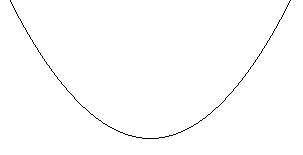
Exponential:
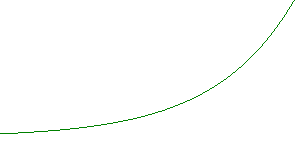
Odd power:
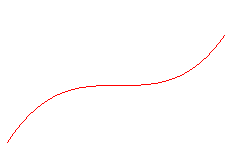
Fractional positive power:
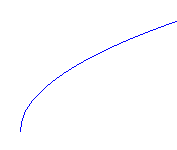
Even negative power:
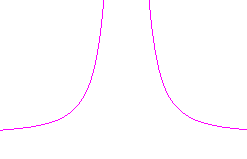
partial graph of polynomial of degree 3

more extensive graph of polynomial of degree 3
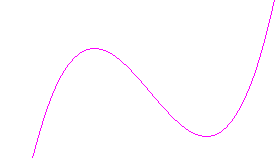
Question: `q007. Let y = 2 x + 3. (Note: Liberal Arts Mathematics students are encouraged to do this problem, but are not required to do it).
Evaluate y for x = -2. What is your result? In your solution explain the steps you took to get this result.
Evaluate y for x values -1, 0, 1 and 2. Write out a copy of the table below. In your solution give the y values you obtained in your table.
x y -2 -1 0 1 2
Sketch a graph of y vs. x on a set of coordinate axes resembling the one shown below. You may of course adjust the scale of the x or the y axis to best depict the shape of your graph.
In your solution, describe your graph in words, and indicate which of the graphs depicted previously your graph most resembles. Explain why you chose the graph you did.
Your solution:
Confidence Rating:
Given Solution:
Two slightly different explanations are give below, one by a
student and one by the instructor. Neither format is inherently better
than the other.
GOOD SOLUTION BY STUDENT:
First we need to complete the table. I have added a column to the right of the table to show the calculation of “y” when we us the “x” values as given.
| x | y | Calculation: If y = 2x + 3 |
| -2 | -1 | If x = -2, then y = 2(-2)+3 = -4+3 = -1 |
| -1 | 1 | If x= -1, then y = 2(-1)+3 = -2+3 = 1 |
| 0 | 3 | If x= 0, then y = 2(0)+3 = 0+3 = 3 |
| 1 | 5 | If x= 1, then y = 2(1)+3 = 2+3 = 5 |
| 2 | 7 | If x= 2, then y = 2(2)+3 = 4+3 = 7 |
Once an answer has been determined, the “y” value can be filled in. Now we have
both the “x” and “y” values and we can begin our graph. The charted values
continue on a straight line representing a linear function as shown above.
INSTRUCTOR'S SOLUTION:
We easily evaluate the expression:
Filling in the table we have
| x | y |
| -2 | -1 |
| -1 | 1 |
| 0 | 3 |
| 1 | 5 |
| 2 | 7 |
When we graph these points we find that they lie along a straight line.
Only one of the depicted graphs consists of a straight line, and we conclude that the appropriate graph is the one labeled 'linear'.
Self-critique (if necessary):
Self-critique Rating:
Question: `q008. Let y = x^2 + 3. (Note: Liberal Arts Mathematics students are encouraged to do this problem, but are not required to do it).
Evaluate y for x = -2. What is your result? In your solution explain the steps you took to get this result.
Evaluate y for x values -1, 0, 1 and 2. Write out a copy of the table below. In your solution give the y values you obtained in your table.
x y -2 -1 0 1 2
Sketch a graph of y vs. x on a set of coordinate axes resembling the one shown below. You may of course adjust the scale of the x or the y axis to best depict the shape of your graph.
In your solution, describe your graph in words, and indicate which of the graphs depicted previously your graph most resembles. Explain why you chose the graph you did.
Your solution:
Confidence Rating:
Given Solution:
Evaluating y = x^2 + 3 at the five points:
If x = -2 then we obtain y = x^2 + 3 = (-2)^2 + 3 = 4 + 3 = 7.
If x = -1 then we obtain y = x^2 + 3 = (-1)^2 + 3 = ` + 3 = 4.
If x = 0 then we obtain y = x^2 + 3 = (0)^2 + 3 = 0 + 3 = 3.
If x = 1 then we obtain y = x^2 + 3 = (1)^2 + 3 = 1 + 3 = 4.
If x = 2 then we obtain y = x^2 + 3 = (2)^2 + 3 = 4 + 3 = 7.
The table becomes
x y -2 7 -1 4 0 3 1 4 2 7
We note that there is a symmetry to the y values. The lowest y value is 3, and whether we move up or down the y column from the value 3, we find the same numbers (i.e., if we move 1 space up from the value 3 the y value is 4, and if we move one space down we again encounter 4; if we move two spaces in either direction from the value 3, we find the value 7).
A graph of y vs. x has its lowest point at (0, 3).
If we move from this point, 1 unit to the right our graph rises 1 unit, to (1, 4), and if we move 1 unit to the left of our 'low point' the graph rises 1 unit, to (-1, 4).
If we move 2 units to the right or the left from our 'low point', the graph rises 4 units, to (2, 7) on the right, and to (-2, 7) on the left.
Thus as we move from our 'low point' the graph rises up, becoming increasingly steep, and the behavior is the same whether we move to the left or right of our 'low point'. This reflects the symmetry we observed in the table. So our graph will have a right-left symmetry.
Two of the depicted graphs curve upward away from the 'low point'. One is the graph labeled 'quadratic or parabolic'. The other is the graph labeled 'partial graph of degree 3 polynomial'.
If we look closely at these graphs, we find that only the first has the right-left symmetry, so the appropriate graph is the 'quadratic or parabolic' graph.
Self-critique (if necessary):
Self-critique Rating:
Question: `q009. Let y = 2 ^ x + 3. (Note: Liberal Arts Mathematics students are encouraged to do this problem, but are not required to do it).
Evaluate y for x = 1. What is your result? In your solution explain the steps you took to get this result.
Evaluate y for x values 2, 3 and 4. Write out a copy of the table below. In your solution give the y values you obtained in your table.
x y 1 2 3 4
Sketch a graph of y vs. x on a set of coordinate axes resembling the one shown below. You may of course adjust the scale of the x or the y axis to best depict the shape of your graph.
In your solution, describe your graph in words, and indicate which of the graphs depicted previously your graph most resembles. Explain why you chose the graph you did.
Your solution:
Confidence Rating:
Given Solution:
Recall that the exponentiation in the expression 2^x + 1 must be done before, not after the addition.
When x = 1 we obtain y = 2^1 + 3 = 2 + 3 = 5.
When x = 2 we obtain y = 2^2 + 3 = 4 + 3 = 7.
When x = 3 we obtain y = 2^3 + 3 = 8 + 3 = 11.
When x = 4 we obtain y = 2^4 + 3 = 16 + 3 = 19.
x y 1 5 2 7 3 11 4 19
Looking at the numbers in the y column we see that they increase as we go down the column, and that the increases get progressively larger. In fact if we look carefully we see that each increase is double the one before it, with increases of 2, then 4, then 8.
When we graph these points we find that the graph rises as we go from left to right, and that it rises faster and faster. From our observations on the table we know that the graph in fact that the rise of the graph doubles with each step we take to the right.
The only graph that increases from left to right, getting steeper and steeper with each step, is the graph labeled 'exponential'.
Self-critique (if necessary):
Self-critique Rating:
Question: `q010. If you divide a certain positive number by 1, is the result greater than the original number, less than the original number or equal to the original number, or does the answer to this question depend on the original number?
Your solution:
Confidence Rating:
Given Solution: If you divide any number by 1, the result is the same as the original number. Doesn't matter what the original number is, if you divide it by 1, you don't change it.
Self-critique (if necessary):
Self-critique Rating:
Question: `q011. If you divide a certain positive number by a number greater than 1, is the result greater than the original number, less than the original number or equal to the original number, or does the answer to this question depend on the original number?
Your solution:
Confidence Rating:
Given Solution: If you split something up into equal parts, the more parts you have, the less will be in each one. Dividing a positive number by another number is similar. The bigger the number you divide by, the less you get.
Now if you divide a positive number by 1, the result is the same as your original number. So if you divide the positive number by a number greater than 1, what you get has to be smaller than the original number. Again it doesn't matter what the original number is, as long as it's positive.
Students will often reason from examples. For instance, the following reasoning might be offered:
OK, let's say the original number is 36. Let's divide 36 be a few numbers and see what happens:
36/2 = 18. Now 3 is bigger than 2, and
36 / 3 = 12. The quotient got smaller. Now 4 is bigger than 3, and
36 / 4 = 9. The quotient got smaller again. Let's skip 5 because it doesn't divide evenly into 36.
36 / 6 = 4. Again we divided by a larger number and the quotient was smaller.
I'm convinced.
That is a pretty convincing argument, mainly because it is so consistent with our previous experience. In that sense it's a good argument. It's also useful, giving us a concrete example of how dividing by bigger and bigger numbers gives us smaller and smaller results.
However specific examples, however convincing and however useful, don't actually prove anything. The argument given at the beginning of this solution is general, and applies to all positive numbers, not just the specific positive number chosen here.
Self-critique (if necessary):
Self-critique Rating:
Question: `q012. If you divide a certain positive number by a positive number less than 1, is the result greater than the original number, less than the original number or equal to the original number, or does the answer to this question depend on the original number?
Your solution:
Confidence Rating:
Given Solution: If you split something up into equal parts, the more parts you have, the less will be in each one. Dividing a positive number by some other number is similar. The bigger the number you divide by, the less you get. The smaller the number you divide by, the more you get.
Now if you divide a positive number by 1, the result is the same as your original number. So if you divide the positive number by a positive number less than 1, what you get has to be larger than the original number. Again it doesn't matter what the original number is, as long as it's positive.
Self-critique (if necessary):
Self-critique Rating:
Question: `q013. Students often get the basic answers to nearly all, or even all these questions, correct. Your instructor has however never seen anyone who addressed all the subtleties in the given solutions in their self-critiques, and it is very common for a student to have given no self-critiques. It is very likely that there is something in the given solutions that is not expressed in your solution.
This doesn't mean that you did a bad job. If you got most of the 'answers' right, you did fine.
However, in order to better understand the process, you are asked here to go back and find something in one of the given solutions that you did not address in your solution, and insert a self-critique. You should choose something that isn't trivial to you--something you're not 100% sure you understand.
If you can't find anything, you can indicate this below, and the instructor will point out something and request a response (the instructor will select something reasonable, but will then expect a very good and complete response). However it will probably be less work for you if you find something yourself.
Your response should be inserted at the appropriate place in this document, and should be indicated by preceding it with ####.
As an answer to this question, include a copy of whatever you inserted above, or an indication that you can't find anything.
Your answer:
Submit a copy of this document using the Submit Work Form (detailed URL is http://vhcc2.vhcc.edu/dsmith/submit_work.htm). The form has instructions but read the following:
It is suggested that you bookmark the Submit Work Form now, but if you don't you will be reminded later.